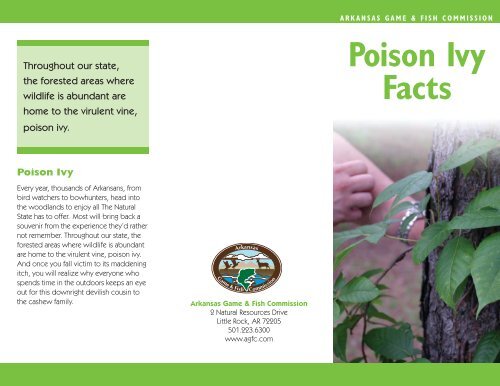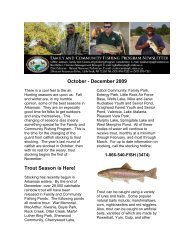Poison Ivy Facts - Arkansas Game and Fish Commission
Poison Ivy Facts - Arkansas Game and Fish Commission
Poison Ivy Facts - Arkansas Game and Fish Commission
- No tags were found...
Create successful ePaper yourself
Turn your PDF publications into a flip-book with our unique Google optimized e-Paper software.
ARKANSAS GAME & FISH COMMISSIONThroughout our state,the forested areas wherewildlife is abundant arehome to the virulent vine,poison ivy.<strong>Poison</strong> <strong>Ivy</strong><strong>Facts</strong><strong>Poison</strong> <strong>Ivy</strong>Every year, thous<strong>and</strong>s of Arkansans, frombird watchers to bowhunters, head intothe woodl<strong>and</strong>s to enjoy all The NaturalState has to offer. Most will bring back asouvenir from the experience they’d rathernot remember. Throughout our state, theforested areas where wildlife is abundantare home to the virulent vine, poison ivy.And once you fall victim to its maddeningitch, you will realize why everyone whospends time in the outdoors keeps an eyeout for this downright devilish cousin tothe cashew family.<strong>Arkansas</strong> <strong>Game</strong> & <strong>Fish</strong> <strong>Commission</strong>2 Natural Resources DriveLittle Rock, AR 72205501.223.6300www.agfc.com
<strong>Poison</strong> <strong>Ivy</strong>:<strong>Facts</strong> about the fiendThe rash poison ivy delivers is actuallycaused by sticky, extremely virulent oilcalled urushiol. Not only can contact withthe plant cause a rash, but urushiol alsocan be transferred indirectly via contactwith anything (clothing, equipment, evenpets <strong>and</strong> downed game).Sensitivity to urushiol oil developsafter the first direct skin contact, <strong>and</strong>an allergic reaction seldom occurs onthe first exposure. About 85 percentof all people will eventually developan allergic reaction when adequatelyexposed.As with many allergies, sensitivity to thistoxin may increase or decrease with age,so the best bet is to stay away, even ifyou’ve never had a problem with thispesky plant in the past.Know your enemyThe best protection against poison ivyis recognition. Although it can take onmany forms – including a tree-dwellingvine, a bushy shrub <strong>and</strong> sprawlingground cover – poison ivy can beidentified by a few key characteristics.The leaves are separated into threedistinct leaflets with smooth or serratededges <strong>and</strong> fuzzy undersides. The woodyvine has a hairy texture that’s also easilyidentified. During fall, the plant producesclusters of cream-colored berries (alsopoisonous) <strong>and</strong> the leaves may take on acrimson or gold hue.Should you come into contact with poisonivy, immediately rinse the area suspectedof contamination with cold water. Usinghot water can increase the severity of therash by opening the pores of your skin.If you contract a rash, over-the-countermedications like calamine <strong>and</strong> Benadryl mayprovide temporary relief, but in severe cases,contact a physician. Cortisone cream or acortisone injection will reduce discomfort,<strong>and</strong> if caught early enough, may eliminate thereaction altogether.<strong>Poison</strong> <strong>Ivy</strong><strong>Poison</strong> ivy pitfallsOne common misconception aboutpoison ivy is that if you scratch the rashor pop the blisters, the rash will spread.The fluid in the blisters does not containurushiol. Areas that have been lightlyexposed or exposed through indirectcontact with urushiol on clothing orequipment will begin to break out afterthe main rash. This gives the appearancethat scratching is spreading the rash.However, your fingernails can trapbacteria, which cause infection, so it isbest to not scratch, which is easier saidthan done.Another common mistake is thinkingthat poison ivy is no longer a threat inwinter when it goes dormant or dies.Although the leaves are gone, urushioloil is found in all parts of the plant,including the vine <strong>and</strong> roots, <strong>and</strong> canremain toxic for months, sometimesyears, after the plant’s demise.Never burn poison ivy to eliminateit. The toxin contained in the plant canbe carried in smoke <strong>and</strong> inhaled. Onceinside your system, what otherwisewould be an uncomfortable rash couldbe a life-threatening ailment.
















